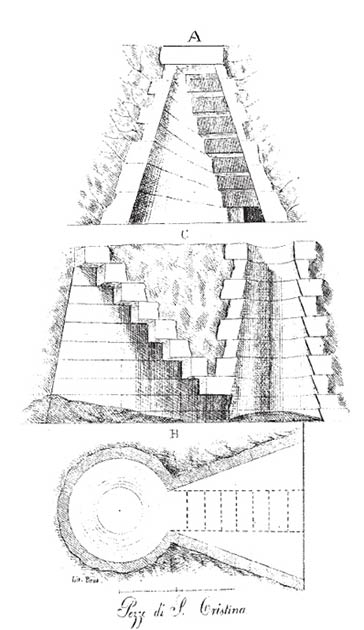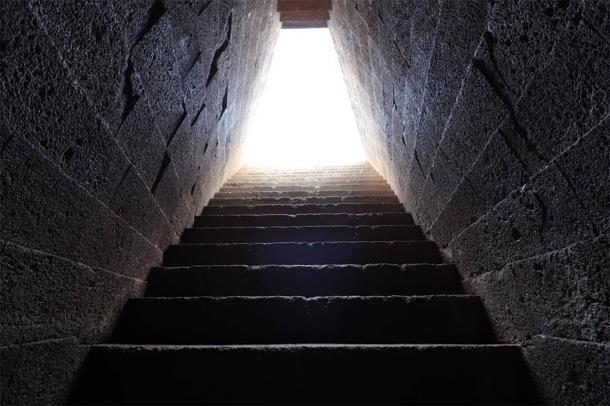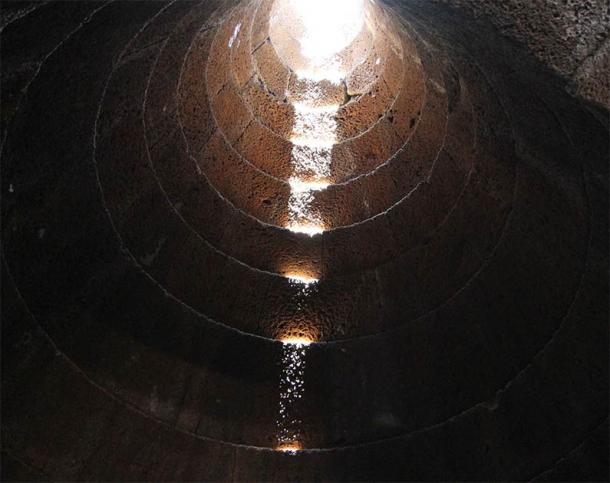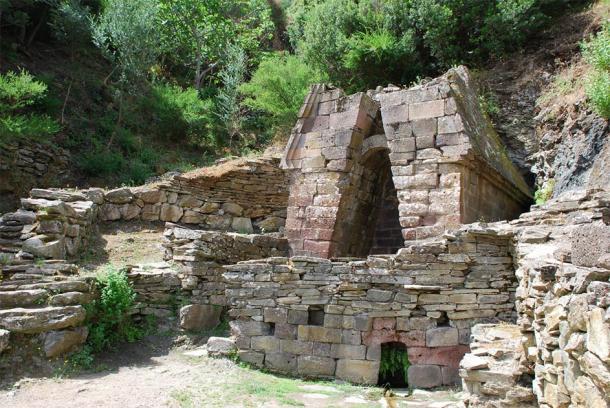The Well of Santa Cristina is an ancient structure located on the Italian island of Sardinia. The name of the structure is somewhat misleading. In spite of its association with a Christian saint, the well has little to do with the Christian faith. In fact, it was constructed during the Bronze Age, long before the coming of Christianity. Apart from that, the Well of Santa Cristina was not used exactly as a well, in the sense that water was drawn from it, but as a ritual site. Whilst such sacred wells have been found throughout Sardinia, the Well of Santa Cristina is one of the best-preserved of its kind.

Nuragic Culture and their Nuraghi Constructions in Sardinia
During the Bronze Age, the island of Sardinia was occupied by an ancient people known as the Nuragic culture. It is generally accepted that this culture flourished from around around 1800 BC to 238 BC, when Sardinia was colonized by the Romans. The Nuragic culture is shrouded in mystery, in part due to them not leaving behind any substantial written records. The mystery is deepened by the fact that this culture built many monumental stone structures around Sardinia, including sacred wells.
Incidentally, the name given to this culture, i.e. Nuragic, is derived from the nuraghe (plural: nuraghi), which are the most characteristic constructions of this Bronze Age culture. A nuraghe is a stone tower typically built using an architectural style called cyclopic. This style involves the use of roughly cut polygonal stones, one superimposed over another. In some instances, mud and mortar were found within the nuraghi, suggesting that these materials may have been used to hold the stones together, and to stabilize the tower. Yet other nuraghi were constructed using the isodomic style. This involved the use of uniformly cut stones in the building of the towers.
Whilst the exact number of nuraghi on Sardinia is unknown, it is certain that they are in the thousands. One source, for instance, states that there are at least 7,000 of these stone towers on the island, whereas another claims that there are at least 8,000. This large number of monumental stone towers is an indication that the people of the Nuragic culture were master architects and builders. The nuraghi, however, are not the only type of building that was being built by the Nuragic culture.

1857 diagram of the Well of Santa Cristina in Sardinia.(Aga Khan / CC BY-SA 3.0)
Sacred Wells of the Nuragic Culture
Sacred wells, though less famous than the nuraghi, are also excellent examples of the building skills possessed by the Nuragic culture. The number of these Nuragic sacred wells is much fewer than the more famous towers. At present, around fifty of these wells have been identified. The most iconic and best-preserved of these in the Well of Santa Cristina. This Nuragic well is situated near the municipality of Paulilatino, in the western part of Sardinia, Italy.
The Well of Santa Cristina derives its name from the fact that it is located close to the Church of Santa Cristina, which was built between the 11 th and 13 th centuries. Not much remains of this Medieval church today, which includes part of the apse, and 36 muristenes, which function as small lodgings for pilgrims. Interestingly, these muristenes are still in use, as they continue to host pilgrims who come in mid-May to honor Santa Cristina with novenas, and at the end of October, when they come to honor the archangel Raphael.

The Well of Santa Cristina is a stunning example of Nuragic architecture located in Paulilatino, Sardinia. Source: murasal / Adobe Stock
What Do We Know About the Well of Santa Cristina?
The Well of Santa Cristina is much older than this rural church, and it dates to around the 11 th century BC. On the surface, the well is surrounded by two temene (singular: temenos), the first of which is an elliptical enclosure. This enclosure is made of stone, and most likely served as a barrier between the sacred space within it, and the profane space without it. This elliptical temenos surrounds a second temenos, which has a lock-shape. Inside this second temenos is the entrance to the well.
The entrance, which is trapezoid opening, is connected to the bottom of the well via a flight of stairs. The stones used for the construction of the entrance and stairs are quite different from those of the temene. For instance, the joining walls are 7 meters (23 ft) thick. Additionally, it is not difficult to notice that the surfaces of these stones are smooth and perfectly-squared. It looks as though the entrance and stairs were made in the not-too-distant past, rather than long ago during the Bronze Age.
Deciphering the Meaning of Water in Nuragic Culture
The fine workmanship of the stones is not the only impressive feature of the Well of Santa Cristina. At the bottom end of the flight of stairs is the subterranean chamber, where water is contained. This underground chamber rises in a conical shape (a tholos, or false dome), terminating in an opening right above the well. It is speculated, however, that the sacred well was originally covered when it was being used by the Nuragic people. This is based on the example of another sacred well, Su Tempiesu, located not far from Orune.
The water in the sacred well comes from an underground spring, brought into the chamber by a tank dug into the bedrock. The connection of this tank to the spring means that the water level in the chamber would remain constant throughout the year. One interpretation of the well, based on the presence of the water, is that it was dedicated to a water cult. It is also suggested that, like the Medieval Church of Santa Cristina, the ancient well attracted Nuragic pilgrims from all over the island.
Unfortunately, not much is known for certain about the rituals the ancient Nuragic peoples may have performed in the sacred well. Nevertheless, scholars have found that symbolic representations of fertility played an important role in Nuragic religion, and that they had a water cult that invoked the various feminine aspects of the divine.

The underground chamber rises in a conical shape, or tholos. (Carlo Pelagalli / CC BY-SA 3.0)
Equinoxes and the Lunistice: Was it an Astronomical Observatory?
Although some have connected the Well of Santa Cristina with a Nuragic water cult, others have suggested that the well was once used as a sort of astronomical observatory. This idea was first proposed by Arnold Lebeuf, a professor at the Jagiellonian University in Cracow, Poland. It has been pointed out that during the spring and autumn equinoxes, the Sun would align perpendicularly with the opening of the well’s tholos, thereby allowing its rays to enter the underground chamber via this aperture. Whilst most sources assume that this phenomenon can still be seen today, one source states that this was only visible in the past, when “the earth’s axis was tilted and Rigel Kent (even called Alfa Centauri, the closest star of the system) was visible from the island.”
Additionally, it was found that an astronomical phenomenon related to the Moon could be observed at the Well of Santa Cristina. At the lunistice (known also as lunar standstill, and is similar to the solstice), the Moon would align perpendicularly with opening of the well’s tholos, illuminating the chamber by its reflection in the water. This phenomenon supposedly occurs once every 18.5 years, the last time being in 2006.
It is not entirely clear if the ancient Nuragic builders had these astronomical observations in mind when they constructed the Well of Santa Cristina, leading to the suggestion that the alignment of the Sun and Moon with the opening of the tholos, during the spring and autumn equinoxes and lunistice respectively, as mere coincidence. Indeed, with not much evidence at the site, or any written records, that support either view, it is hard to say which is the correct one.

Just 200 meters away is the Santa Cristina Nuraghe, a single tower covered by an intact vault. (Angelo Calvino / Adobe Stock)
Capanna delle riunioni and the Santa Cristina Nuraghe
Although the Well of Santa Cristina is the highlight of the archaeological site, the other Nuragic elements in the vicinity should be explored as well. In the area outside the sacred enclosure, archaeologists have uncovered the remains of a Nuragic settlement. The most enigmatic of these remains in the settlement is the so-called Capanna delle riunioni (meaning “meeting hut”).
The meeting hut is a circular building with seating around the walls. The hut is 10 meters (32.8 ft) in diameter, is paved with pebbles, and has another dozen rooms connected to it. It has been speculated that these rooms may have been used as shops, which would have catered to the needs of the pilgrims who came to the sacred well. Alternatively, it has been suggested that the rooms were the homes of the priests who performed the rituals at the well.
About 200 meters (656 ft) from the Well of Santa Cristina and the Nuragic settlement is a nuraghe, which is called the Santa Cristina Nuraghe. This is a single tower with a simple circular shape, measuring 6 meters (19.7 ft) in height, and 13 meters (42.7 ft) in diameter. The tower consists of a main chamber which is accessed via a short corridor. This chamber is covered by an intact vault, and has three subsidiary cells attached to it. The Santa Cristina Nuraghe was once surrounded by a large village, the remains of which can still be seen today. This village was initially inhabited by the Nuragic culture. Later on, people from other cultures replaced the original residents of the village.

There are about fifty sacred wells of the Nuragic culture on the island of Sardinia. One of them is the Su Tempiesu near Orune which is believed to have functioned as a votive well. (Wolfgang Cibura / Adobe Stock)
What About the Other Sacred Wells of the Nuragic Culture?
Although the Well of Santa Cristina is the best example of a Nuragic sacred well, it is not the only one. As mentioned earlier, around fifty of these wells have been identified around Sardinia. Some of the more notable wells include Su Tempiesu, Sa Testa, and Predio Canopoli.
The first of these three wells is located near Orune, in the eastern part of Sardinia. This well is located against a rock face, and is the “only original evidence still remaining of a covered sacred well structure built on elevation.” This temple measures 7 meters (23 ft) in height, and consists of a vestibule, a flight of stairs, and a chamber to protect the vein of spring water.
The covering / roof of the well is arguably its most impressive feature, and constitutes “a double sloping roof with double sculpted eaves,” culminating in a triangular tympanum. In the past, the roof was topped with an acroterion, which supported twenty votive bronze swords. These weapons are decorated, and have holes made deliberately in them. Other bronze votive offerings, including statuettes, daggers, rings, and pendants, have also been found. The presence of these artefacts in Su Tempiesu supports the idea that the site functioned as a votive well.
The other two wells, Sa Testa, and Predio Canopoli, bear closer resemblance to the Well of Santa Cristina. The former is located close to Olbia, whereas the latter is situated near Perfugas, in the northeastern, and northern parts of the island respectively. Sa Testa is situated between a pair of hills, and votive offerings have also been found there, whilst Predio Canopoli, like the Well of Santa Cristina, is notable for its smooth and perfectly-squared blocks of stones.
Another noteworthy aspect of the sacred well at Predio Canopoli is that it is adjacent to a megaron-style temple. In ancient Greece, the megaron was the great hall in a palace complex, and it is speculated that this architectural feature was introduced to the Nuragic culture by Greek or Phoenician settlers. Incidentally, there is no mention of any astronomical phenomenon occurring at either of these two sacred wells, or at Su Tempiesu.
Lastly, it may be said that the numerous sacred wells across Sardinia is an indication of the important role played by water in the lives of the Nuragic people. The significance of water becomes clearer when one considers the parched landscape of Sardinia. Thus, water, for the Nuragic culture, became associated with the divine. Although the Nuragic culture ultimately went extinct, it seems that their water cult continued to exist, and was adopted by those who occupied Sardinia after them. This is evident in the fact that Roman votive offerings have been found at some of these ancient sacred wells. Even when this water cult died out, presumably with the coming of Christianity, the stone structures themselves survived till this day, serving as a reminder that the Nuragic people were great architects and builders, and perhaps, even astronomers.